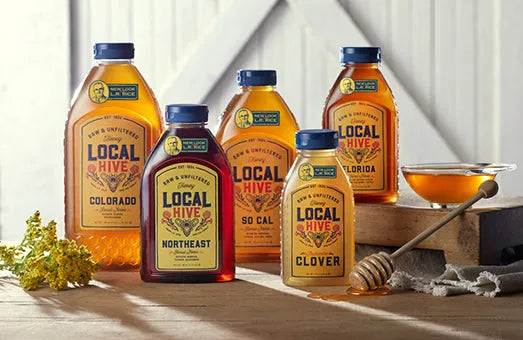The Difference Between Light and Dark Honey
Honey Facts
Like The Force, honey is a magical substance with a light side and a dark side that’s mysteriously made by tiny living things. We have nearly a dozen Star Wars movies to explain The Force to us, but what is it that makes honey light or dark? Read on, you must.
Honey gets its color from the pollen that a hive gathers to make it. Because plants blossom at different times of year and bees collect honey nearly year-round, a single hive can produce radically different colors of honey from season to season. You can see a great example of this phenomenon here, with plenty of discussion from the local beekeeper who produced the honey. All that changes is the bees’ pollen source: what we in the buzz biz call a “varietal.”
So, now that we know where they come from, how do light and dark honeys taste?
In her book The Honey Connoisseur, Marina Marchese describes the limit of what you can learn about honey from color alone: “Each varietal of honey generally falls within a color range, with slight variations…but color does not always correspond to what we expect to taste.”
The common wisdom is that light honeys are mild while dark honeys are heavy and rich. This is generally true, with some exceptions. For example, goldenrod pollen will make honey darker, but doesn’t bring along particularly intense tasting notes. Meanwhile, tupelo honey is prized for its strong, fruity flavor but is almost always a light, translucent yellow color.
Bees use whatever pollen they can find, so if lots of plants are in bloom, the honey that results will be a unique mix of different varietals with an equally unique color and flavor. Single-varietal honeys, like clover, have more consistent taste but can only be produced when and where that one plant is in bloom.
That leaves one question: what about the honey in the middle?
Most honey on store shelves isn’t particularly light or dark. It’s more of a golden-orange color, consistent from bottle to bottle and brand to brand. You’d be forgiven for thinking that translucent goo in a bear-shaped bottle is honey in its natural state. But that middle-of-the-road honey has to be heavily processed, blended and pasteurized to end up that way. All those “unusual” light and dark honeys are what honey really looks like. They’re more likely to be pure, raw and unfiltered honey.
Even though their colors range from what beekeepers call “water white” to “motor-oil black,” raw and unfiltered varietal honeys are almost always cloudy and opaque, with their natural pollen––and flavor––still intact. Shop for honey by cloudiness, not color, and you won’t be disappointed.
Every bottle of raw and unfiltered honey––light or dark––has its own origin story, one that started a long time ago in a hive far, far away.
